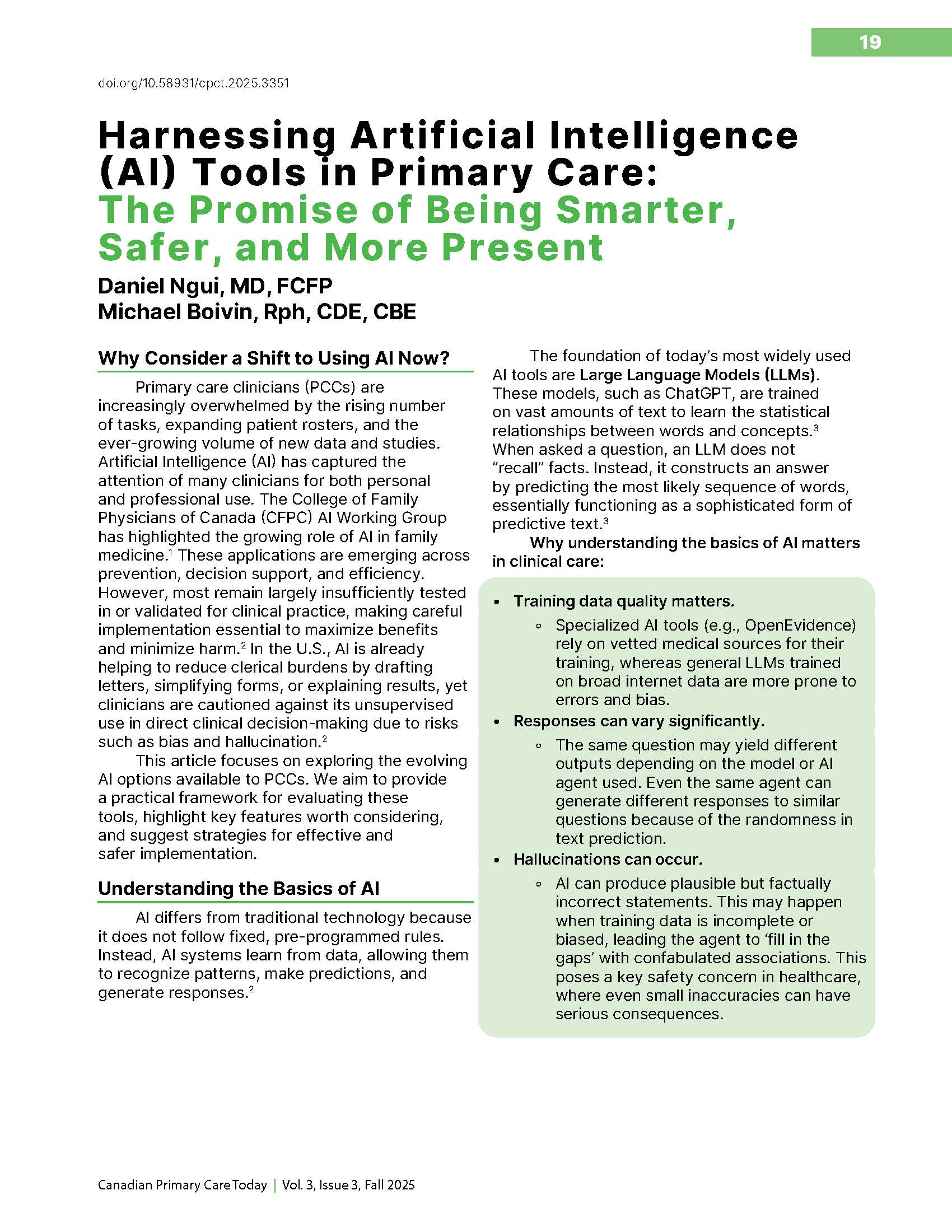Harnessing Artificial Intelligence (AI) Tools in Primary Care: The Promise of Being Smarter, Safer, and More Present
DOI:
https://doi.org/10.58931/cpct.2025.3351Abstract
Primary care clinicians (PCCs) are increasingly overwhelmed by the rising number of tasks, expanding patient rosters, and the ever‑growing volume of new data and studies. Artificial Intelligence (AI) has captured the attention of many clinicians for both personal and professional use. The College of Family Physicians of Canada (CFPC) AI Working Group has highlighted the growing role of AI in family medicine. These applications are emerging across prevention, decision support, and efficiency. However, most remain largely insufficiently tested in or validated for clinical practice, making careful implementation essential to maximize benefits and minimize harm. In the U.S., AI is already helping to reduce clerical burdens by drafting letters, simplifying forms, or explaining results, yet clinicians are cautioned against its unsupervised use in direct clinical decision-making due to risks such as bias and hallucination.
This article focuses on exploring the evolving AI options available to PCCs. We aim to provide a practical framework for evaluating these tools, highlight key features worth considering, and suggest strategies for effective and safer implementation.
References
Kueper JK. Primer for artificial intelligence in primary care. Can Fam Physician. 2021;67(12):889–893. doi:10.46747/cfp.6712889 DOI: https://doi.org/10.46747/cfp.6712889
Waldren SE. The promise and pitfalls of AI in primary care. Fam Pract Manag. 2024;31(2):27-31.
McCoy LG, Ci Ng FY, Sauer CM, Yap Legaspi KE, Jain B, Gallifant J, et al. Understanding and training for the impact of large language models and artificial intelligence in healthcare practice: a narrative review. BMC Med Educ. 2024;24(1):1096. Published 2024 Oct 7. doi:10.1186/s12909-024-06048-z DOI: https://doi.org/10.1186/s12909-024-06048-z
Dubey S, Ghosh R, Dubey MJ, Chatterjee S, Das S, Benito-León J. Redefining cognitive domains in the era of ChatGPT: a comprehensive analysis of artificial intelligence’s influence and future implications. Med Res Arch. 2024;12(6):5383. doi:10.18103/mra.v12i6.5383 DOI: https://doi.org/10.18103/mra.v12i6.5383
Singh A, Taneja K, Guan Z, Ghosh A. Protecting human cognition in the age of AI [Internet]. arXiv; 2025 [revised 2025 Apr 11, cited 2025 Sep 1]. Available from: http://arxiv.org/abs/2502.12447
Wachter RM, Brynjolfsson E. Will generative artificial intelligence deliver on its promise in health care? JAMA. 2024;331(1):65–69. doi:10.1001/jama.2023.25054 DOI: https://doi.org/10.1001/jama.2023.25054
Bienefeld N, Keller E, Grote G. AI interventions to alleviate healthcare shortages and enhance work conditions in critical care: qualitative analysis. J Med Internet Res. 2025;27:e50852. Published 2025 Jan 13. doi:10.2196/50852 DOI: https://doi.org/10.2196/50852
Canadian Medical Protective Association. CMPA - The medico-legal lens on AI use by Canadian physicians [Internet]. 2024 [published 2024 Sep, cited 2025 Sep 1]. Available from: https://www.cmpa-acpm.ca/en/research-policy/public-policy/the-medico-legal-lens-on-ai-use-by-canadian-physicians
College of Physicians and Surgeons of British Columbia. Ethical principles for artificial intelligence in medicine [Internet]. 2024 [revised 2024 Oct 3, cited 2025 Sep 1]. Available from: https://www.cpsbc.ca/files/pdf/IG-Artificial-Intelligence-in-Medicine.pdf
Canada Health Infoway. AI Scribe Program. Streamlining documentation and reducing administrative burden for primary care clinicians [Internet]. 2025 [cited 2025 Sep 1]. Available from: https://www.infoway-inforoute.ca/en/featured-initiatives/ai-scribe-program
Agarwal P, Lall R, Girdhari R. Artificial intelligence scribes in primary care. CMAJ. 2024;196(30):E1042. Published 2024 Sep 15. doi:10.1503/cmaj.240363 DOI: https://doi.org/10.1503/cmaj.240363
Mess SA, Mackey AJ, Yarowsky DE. Artificial Intelligence scribe and large language model technology in healthcare documentation: advantages, limitations, and recommendations. Plast Reconstr Surg Glob Open. 2025;13(1):e6450. Published 2025 Jan 16. doi:10.1097/GOX.0000000000006450 DOI: https://doi.org/10.1097/GOX.0000000000006450

Published
How to Cite
Issue
Section
License
Copyright (c) 2025 Canadian Primary Care Today

This work is licensed under a Creative Commons Attribution-NonCommercial-NoDerivatives 4.0 International License.
